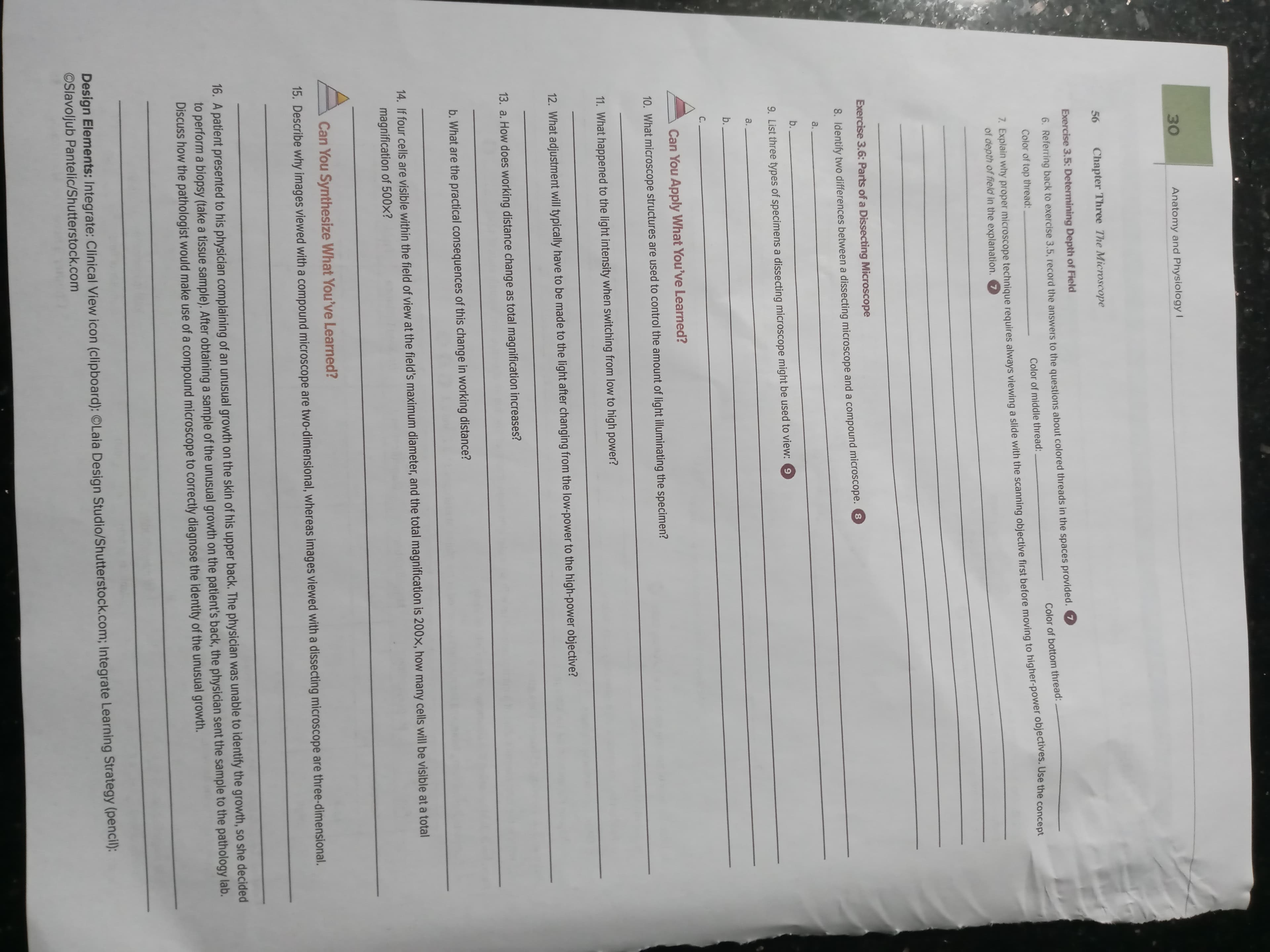(14 00 Do You Know the Basics? Ane 6. Exercise 3.1: Parts of a Compound Microscope Unders 1. Label the parts of the compound microscope. .7 9. 10 11 12 1. 2- 13 14 3- 15 16 ©McGraw-Hill Education/Christine Eckel, photographer
(14 00 Do You Know the Basics? Ane 6. Exercise 3.1: Parts of a Compound Microscope Unders 1. Label the parts of the compound microscope. .7 9. 10 11 12 1. 2- 13 14 3- 15 16 ©McGraw-Hill Education/Christine Eckel, photographer
Chapter14: Seeing And Hearing
Section: Chapter Questions
Problem 4FITB
Related questions
Question

Transcribed Image Text:Anatomy and Physiology I
Chapter Three The Microscope
Exercise 3.5: Determining Depth of Field
6. Referring back to exercise 3.5, record the answers to the questions about colored threads in the spaces provided. 7
Color of bottom thread:
Color of top thread:
Color of middle thread:
* Explalm why proper microscope technique requires always viewing a slide with the scanning objective first before moving to higher-power objectives. Use the concept
of depth of field in the explanation. 7
Exercise 3.6: Parts of a Dissecting Microscope
8. Identify two differences between a dissecting microscope and a compound microscope. 8
a.
b.
9. List three types of specimens a dissecting microscope might be used to view:
a.
b.
Can You Apply What You've Learned?
10. What microscope structures are used to control the amount of light illuminating the specimen?
11. What happened to the light intensity when switching from low to high power?
12. What adjustment will typically have to be made to the light after changing from the low-power to the high-power objective?
13. a. How does working distance change as total magnification increases?
b. What are the practical consequences of this change in working distance?
14. If four cells are visible within the field of view at the field's maximum diameter, and the total magnification is 200×, how many cells will be visible at a total
magnification of 500x?
Can You Synthesize What You've Learned?
15. Describe why images viewed with a compound microscope are two-dimensional, whereas images viewed with a dissecting microscope are three-dimensional.
16. A patient presented to his physician complaining of an unusual growth on the skin of his upper back. The physician was unable to identify the growth, so she decided
to perform a biopsy (take a tissue sample). After obtaining a sample of the unusual growth on the patient's back, the physician sent the sample to the pathology lab.
Discuss how the pathologist would make use of a compound microscope to correctly diagnose the identity of the unusual growth.
Design Elements: Integrate: Clinical View icon (clipboard): ©Laia Design Studio/Shutterstock.com; Integrate Learning Strategy (pencl):
©Slavoljub Pantelíc/Shutterstock.com

Transcribed Image Text:21
6,
00
Laboratory Manual to Accompany Anatomy & Physiology: An Integrative Approach: Main Version, Fourth Edition
Name:
Chapter 3: The Microscope
Date:
Seçtion:
POST-LABORATORY WORKSHEET
The 1 corresponds to the Learning Objective(s) listed in the chapter opener outline.
Create
pue
Evaluate
5.
Analyrs and Apnly
Do You Know the Basics?
Exercise 3.1: Parts of a Compound Microscope
Understand and Remember
1. Label the parts of the compound microscope.
11
12
2
13
14
15
3.
©McGraw-Hill Education/Christine Eckel, photographer
2. Describe how to perform each of the following tasks: 1
a. Transport the microscope.
b. Position the microscope on a laboratory workstation.
c. Clean the microscope lenses.
d. Prepare the microscope for storage.
Exercise 3.2: Viewing a Slide of the Letter e
3. What is the total magnification of a microscope set up with an ocular lens magnification of 10× and an objective lens magnification of 43x?
Exercise 3.3: Measuring the Diameter of the Field of View
4. Complete the following table with the numbers observed or calculated in exercises 3.1, 3.2, and 3.3. 3
4.
Diameter of the
Field of View
Total
Objective
Magnification
Ocular
Power
Magnification
Magnification
Working Distance
Scanning
MOT
High
Exercise 3.4: Estimating the Size of a Specimen
5. Refer back to the calculations on the sample "specimens" in figure 3.5. Enter information from those calculations in the spaces provided. Pay attention to the units
specified next to the answers, because they are not all the same. 6
A.
B.
C.
Total magnification
Total magnification
= 200x
Total magnification = 500x
%3D
%3D
Diameter of field
Diameter of field
Diameter of field
url
%3D
ww 8.
Length of object
Length of object
Length of object
url
Chapter Three The Microscope 55
Expert Solution
This question has been solved!
Explore an expertly crafted, step-by-step solution for a thorough understanding of key concepts.
This is a popular solution!
Trending now
This is a popular solution!
Step by step
Solved in 2 steps

Knowledge Booster
Learn more about
Need a deep-dive on the concept behind this application? Look no further. Learn more about this topic, biology and related others by exploring similar questions and additional content below.Recommended textbooks for you

